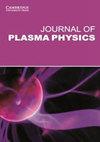The effects of finite electron inertia on helicity-barrier-mediated turbulence
IF 2.1
3区 物理与天体物理
Q2 PHYSICS, FLUIDS & PLASMAS
引用次数: 0
Abstract
Understanding the partitioning of turbulent energy between ions and electrons in weakly collisional plasmas is crucial for the accurate interpretation of observations and modelling of various astrophysical phenomena. Many such plasmas are ‘imbalanced’, wherein the large-scale energy input is dominated by Alfvénic fluctuations propagating in a single direction. In this paper, we demonstrate that when strongly-magnetised plasma turbulence is imbalanced, nonlinear conservation laws imply the existence of a critical value of the electron plasma beta (the ratio of the thermal to magnetic pressures) that separates two dramatically different types of turbulence in parameter space. For betas below the critical value, the free energy injected on the largest scales is able to undergo a familiar Kolmogorov-type cascade to small scales where it is dissipated, heating electrons. For betas above the critical value, the system forms a ‘helicity barrier’ that prevents the cascade from proceeding past the ion Larmor radius, causing the majority of the injected free energy to be deposited into ion heating. Physically, the helicity barrier results from the inability of the system to adjust to the disparity between the perpendicular-wavenumber scalings of the free energy and generalised helicity below the ion Larmor radius; restoring finite electron inertia can annul, or even reverse, this disparity, giving rise to the aforementioned critical beta. We relate this physics to the ‘dynamic phase alignment’ mechanism (that operates under yet lower beta conditions and in pair plasmas), and characterise various other important features of the helicity barrier, including the nature of the nonlinear wavenumber-space fluxes, dissipation rates, and energy spectra. The existence of such a critical beta has important implications for heating, as it suggests that the dominant recipient of the turbulent energy, ions or electrons, can depend sensitively on the characteristics of the plasma at large scales.有限电子惯性对螺旋屏障中介湍流的影响
了解弱碰撞等离子体中离子和电子之间的湍流能量分配对于准确解释各种天体物理现象的观测结果和建模至关重要。许多此类等离子体都是 "不平衡 "的,即大尺度能量输入主要由沿单一方向传播的阿尔费尼波动所主导。在本文中,我们证明了当强磁化等离子体湍流不平衡时,非线性守恒定律意味着电子等离子体β(热压与磁压之比)临界值的存在,该临界值将参数空间中两种截然不同的湍流类型区分开来。当贝塔值低于临界值时,在最大尺度上注入的自由能会以我们所熟悉的科尔莫哥罗夫(Kolmogorov)式级联的方式传递到小尺度上,并在小尺度上耗散,从而加热电子。对于高于临界值的贝塔,系统会形成一个 "螺旋屏障",阻止级联穿过离子的拉莫尔半径,导致大部分注入的自由能沉积到离子加热中。从物理学角度看,螺旋障碍的产生是由于系统无法适应离子拉莫尔半径以下的自由能和广义螺旋的垂直波数标度之间的差异;恢复有限的电子惯性可以消除甚至逆转这种差异,从而产生上述临界贝塔。我们将这一物理机制与 "动态相位对准 "机制(在更低的贝塔条件下和对等离子体中运行)联系起来,并描述了螺旋屏障的其他各种重要特征,包括非线性波数空间通量的性质、耗散率和能谱。这种临界贝塔的存在对加热有重要影响,因为它表明湍流能量的主要接受者(离子或电子)可以敏感地取决于大尺度等离子体的特性。
本文章由计算机程序翻译,如有差异,请以英文原文为准。
求助全文
约1分钟内获得全文
求助全文
来源期刊

Journal of Plasma Physics
物理-物理:流体与等离子体
CiteScore
3.50
自引率
16.00%
发文量
106
审稿时长
6-12 weeks
期刊介绍:
JPP aspires to be the intellectual home of those who think of plasma physics as a fundamental discipline. The journal focuses on publishing research on laboratory plasmas (including magnetically confined and inertial fusion plasmas), space physics and plasma astrophysics that takes advantage of the rapid ongoing progress in instrumentation and computing to advance fundamental understanding of multiscale plasma physics. The Journal welcomes submissions of analytical, numerical, observational and experimental work: both original research and tutorial- or review-style papers, as well as proposals for its Lecture Notes series.
 求助内容:
求助内容: 应助结果提醒方式:
应助结果提醒方式:


